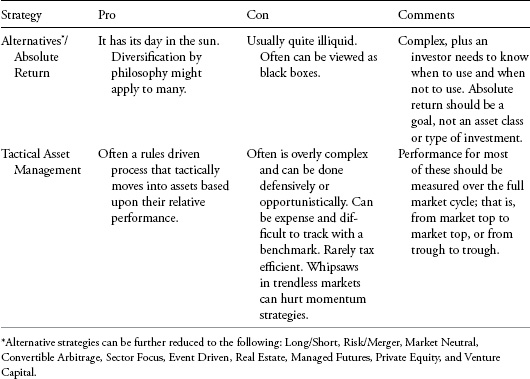Appendix A
Passive versus Active Management
Passive means that the investor or manager does not change the portfolio components except for occasional, usually based on the calendar, rebalancing to some preconceived ratio of stocks and bonds. Passive is prosaic and often is designed just to replicate the market. An active investor or manager is one who attempts to invest in top performing stocks or assets using some methodology to assist in that process. Often it is difficult to tell the difference between some active managers and their benchmark. They have become benchmark huggers, often because of career risk. This is not a complete list, but does address the most popular strategies and while there is some overlap in some strategies, that is not unexpected.
Examples of Passive
- Buy and hold. The concept of long-only investments is usually based on fundamental research. For decades this was the much touted method to long-term success in the stock market, and, in fact, for most people, that is probably correct, especially if much of their holding period was during a secular bull market. Value investing is generally attributed to this type of investing. Sadly, buy and hold can be devastating during secular bear markets. Five of the strong arguments for buy and hold are:
- The market goes up over the long run.
- Equity returns will keep you ahead of inflation.
- The market always recovers from bear markets.
- Commissions, fees, and taxes are kept low.
- No one can time the market’s up and down moves.
- This book is about why those arguments are false. Hopefully when you read them, you were aware that they are not strong arguments at all, but merely selling points for those who benefit from your decision to buy and hold.
- Strategic asset allocation. A very popular process, which basically infers that the investor or manager sets up a portfolio of assets based on their individual risk to return measures. This concept has been the tenant of modern portfolio theory and, like buy and hold, works quite well in secular bull markets. The really sad part is that buy and hold probably will outperform strategic asset allocation in those secular bull markets. Strategic asset allocation almost always involves periodic rebalancing to the predetermined ratio. Personally, I find it hard to adapt to a strategy that sells its best performing assets and buys more of the worst. Peter Mauthe says strategic asset allocation does not have a tactic. Mauthe goes on to say that nothing gets better with neglect. My tire pressure is low, so I can be passive or active in attending to them. Health, relationships, customer relations, nothing I know of gets better with neglect. So why would my investments be any different?
- Portfolio rebalancing seems flawed from its basic premise: selling the best performing assets and buying more of the worst performing assets. Or, selling the best and buying the worst hoping that mean reversion kicks in before you kick off.
- Dollar cost averaging. The act of investing a fixed dollar amount on a periodic basis. This was addressed in more detail in Chapter 2.
Examples of Active
- Momentum. A concept that selects the top-performing assets based on their price performance. While this sounds good, the process does involve determining the period of time to use to measure that performance and usually involves some sort of ranking capability.
- Sector rotation. Somewhat similar to a momentum strategy but restricted to market sectors and sometimes includes the industry groups. This technique is probably easier to put into practice because it involves fewer issues to monitor and measure. One of the problems with this strategy is that it cannot protect you from bear markets, only reduce the pain. If this strategy is long only and the goal is to remain fully invested, then it was described in Chapter 8.
- Alternatives. These strategies usually come to fruition during the mid- to later years of secular bear markets, when investors realize that passive investing is no longer working. Futures, hedging, options, and a whole host of derivative products are used across the board in the alternatives category.
- Absolute return. This falls under the Alternatives header and generally relates to strategies that are totally unconstrained in long, short, hedges, leveraged, and so on. They are not tied to any benchmark, hence, absolute return versus relative return.
- Tactical asset management. This was listed last as this is essentially what this book is all about. Tactical asset management infers that the investor or manager is unconstrained not only in which assets, but when to invest in them.
Table A.1 gives brief comments on the various strategies. With the benefit of hindsight, the market can seem predictable; however, many of these strategies are more useful in describing the market’s past than in anticipating its future.


Table A.1 Pro and Con of Various Strategies
To access an online version of this table, please visit www.wiley.com/go/morrisinvestingebook.
Note: Active management is quite broad. At one end it can be a manager who rebalances a portfolio once a year. This approach rarely uses stop loss protection and is always 100 percent invested, which means it does not ever hold cash or cash equivalents. At the other end of the spectrum is the tactical unconstrained manager, similar to my “Dancing with the Trend” strategy. This is an approach that utilizes stop loss protection, treats cash and cash equivalents as an asset class, and it determined to protect the downside.
